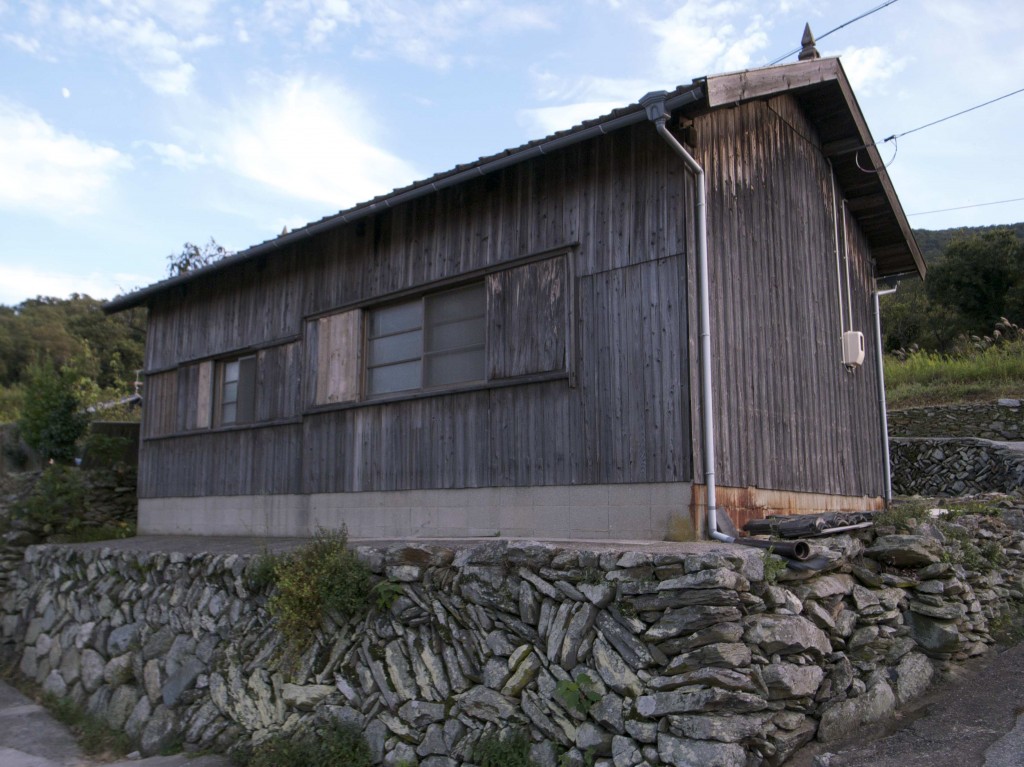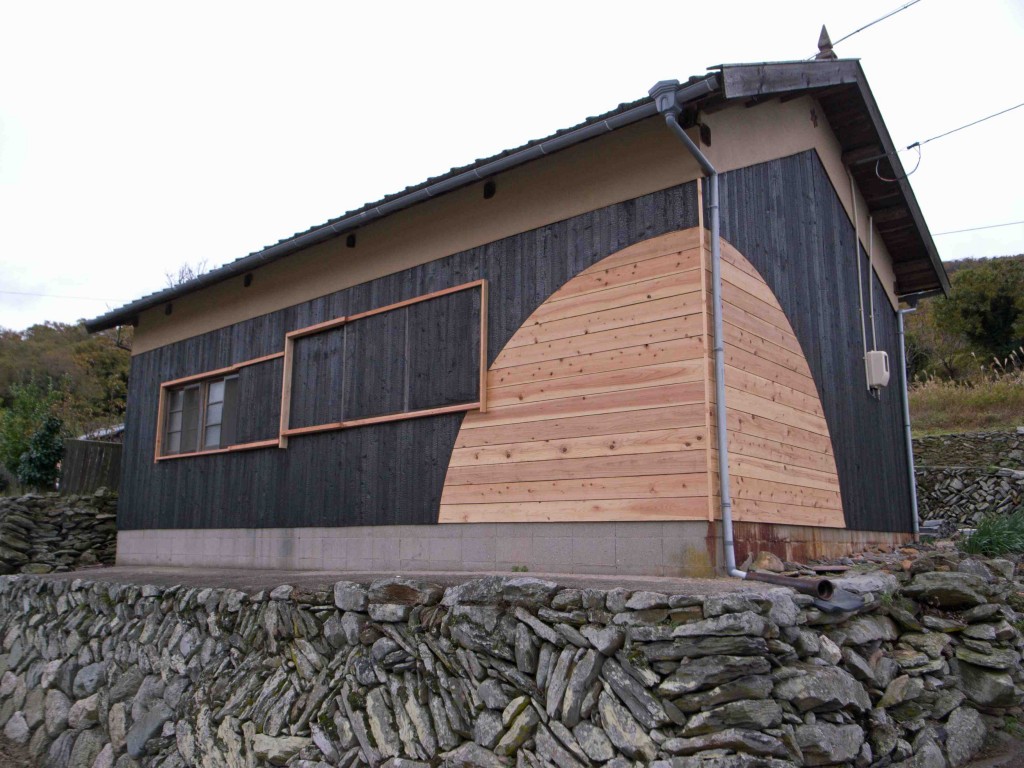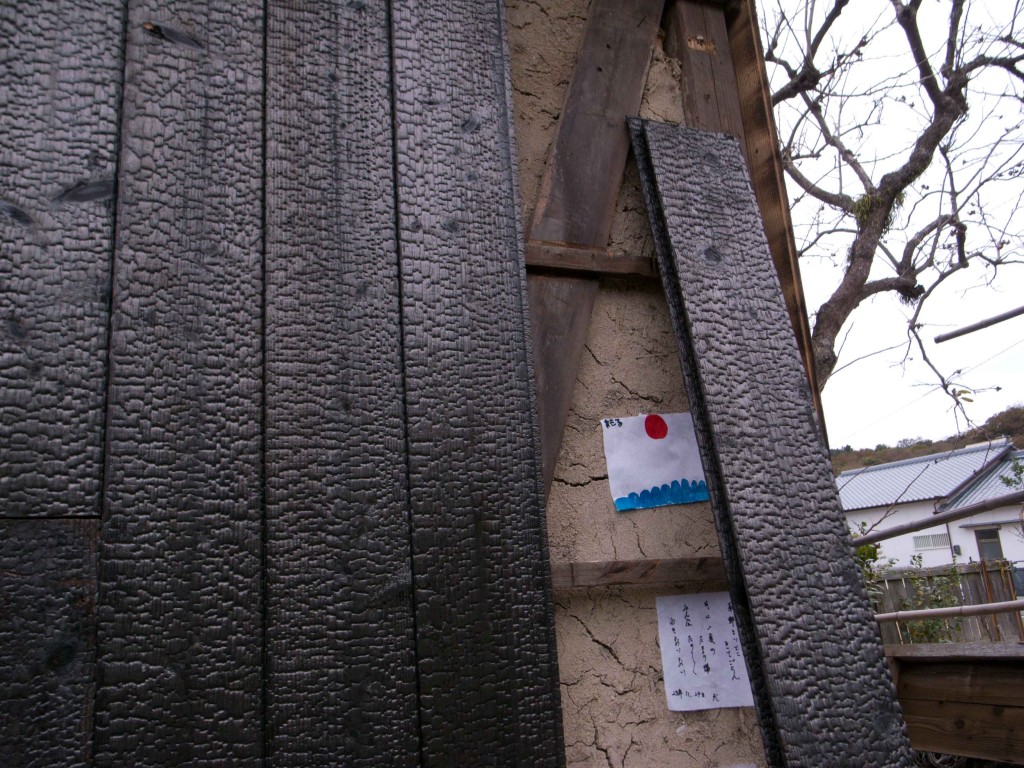As an artist in residence on Shodo Island I have developed many new artworks, most notably the permanent installation work Sunset House. I began research for the work two years ago, redesigned the interior of the house last summer and have been at work on the exterior over the past four months. The site is charged with social history that became apparent to me through daily conversations with the elderly in the area. From their stories I realized that the pillars, roof tiles and other structural materials for this shed were originally part of the “Mutsumi Club” run by the Osaka Sekizai Company. After a typhoon nearly destroyed the clubhouse forty years ago it was relocated by the current owner and used as a storage shed for fishing nets, garden tools and other odd items. Since the owner has passed away over a decade ago the shed had fallen out of use and the space was becoming stale in the absence of a current use.
While listening to the local people’s memories of drinking parties, tea gatherings and many breaks from work that took place at this clubhouse I realized the significance of my work in this specific place at this particular time. No different from most of the islands in Setouchi and the Japanese countryside in general, the population on Shodo Island is decreasing. For school, work, convenience and many other reasons young people are leaving the countryside for urban lifestyles and fewer and fewer couples are having babies. Towns such as Kounoura where I am undertaking this artwork show the signs of decreasing population very clearly. In some areas there are more empty houses than those being lived in and it is easier to find a car with an elderly sticker than one without. In the midst of this complex social history of the place I had to find a way to incorporate the memories, wishes and dreams of these people directly into my art installation.
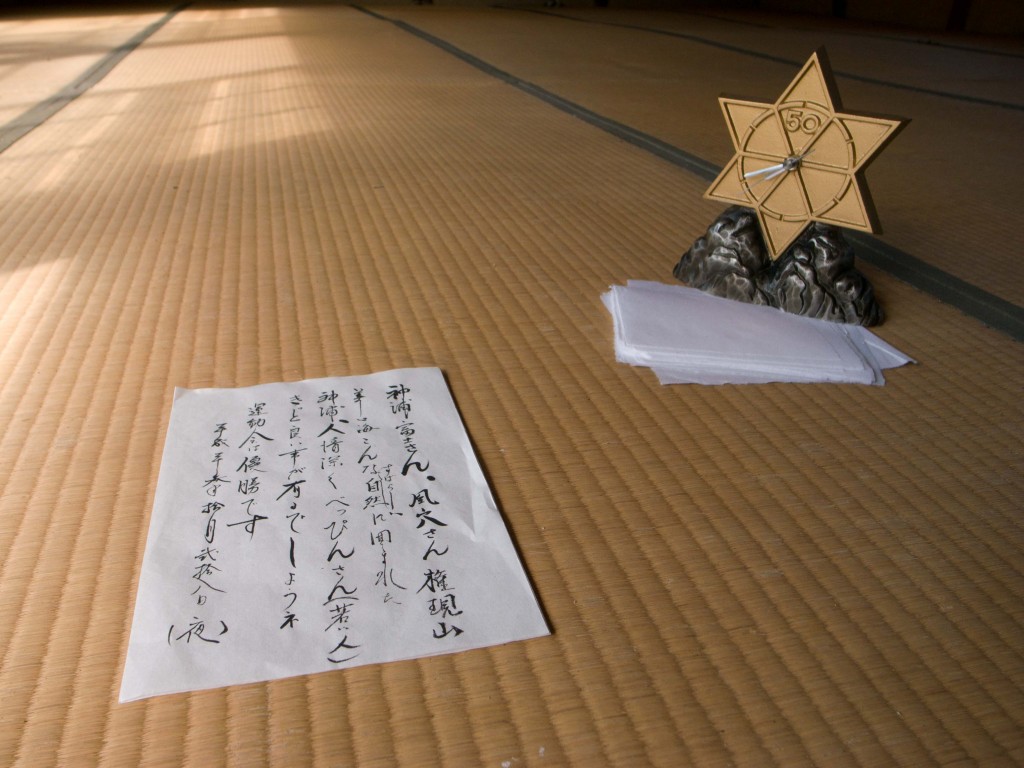 One of the first reasons I was fascinated by this particular shed of all the potential exhibition sites was its raw, cracking mud interior walls. Last year I preserved the characteristics of these walls while mixing white and black stone dust into the compound to create circular forms inside the wall surfaces. (More details of this stage from last year can be found on my website HERE.) This year I envisioned a similar form that suggested a circle for the exterior of the building, but chose to use materials that are commonly used in local architecture. Throughout the process of redesigning the exterior surface, I realized that people’s hopes, memories and wishes could all become an integral part of the walls themselves. I asked the local elderly group to each write a remembrance, dream or wish on a small piece of paper. This became a way for me to learn more about the history of the site and the people living in the community. I soon realized that these wishes were a genuine way for the local community to gain an active voice in the heart of this artwork. Therefore I chose to adhere their paper wishes directly to the mud walls of the building so it would be endowed with the hearts of all those who participate.
One of the first reasons I was fascinated by this particular shed of all the potential exhibition sites was its raw, cracking mud interior walls. Last year I preserved the characteristics of these walls while mixing white and black stone dust into the compound to create circular forms inside the wall surfaces. (More details of this stage from last year can be found on my website HERE.) This year I envisioned a similar form that suggested a circle for the exterior of the building, but chose to use materials that are commonly used in local architecture. Throughout the process of redesigning the exterior surface, I realized that people’s hopes, memories and wishes could all become an integral part of the walls themselves. I asked the local elderly group to each write a remembrance, dream or wish on a small piece of paper. This became a way for me to learn more about the history of the site and the people living in the community. I soon realized that these wishes were a genuine way for the local community to gain an active voice in the heart of this artwork. Therefore I chose to adhere their paper wishes directly to the mud walls of the building so it would be endowed with the hearts of all those who participate.
The first challenge I faced was the question, “But what is the point if these wishes be covered up by the new wood surface?” In conceiving this artwork I did not want to make things obvious, but rather to suggest the larger existence of what is already there. For example, in drawing two circles into the interior of the structure I chose to draw fragments of two larger circles, one opening up to the sky and another opening to the earth in order to suggest that which lies beyond the architecture of the building itself. The same concept held true for the wishes, but even stronger. Precisely because they not visible on the surface of the artwork the wishes impress an emotional message on the mind. That which is obvious, in front of one’s eyes, does not need to be remembered because it is visible; but that which is invisible must be actively remembered, told in a story or represented in media such as photographs. These layers of meaning in the work evolved naturally from the materials and history of the site. Some adults were skeptical at first, but one by one the wishes started pouring in from all types of people. Some residents were so enthusiastic they wrote 3-4 sheets overflowing with creativity, poetry and personal thoughts. I held two workshops, one for a kindergarden class and another for an elderly club in which everyone recorded their memories of sunsets, hopes for the present and dreams for the future. The affixing of countless wishes to the walls recharged the site with a new energy related to its roots as a clubhouse. But instead the space is now transforming into a place where people old and young, local and foreign, can meet to appreciate nature just as it is.
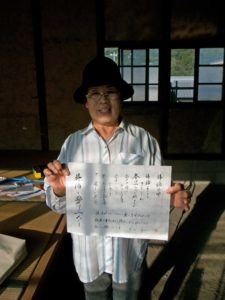
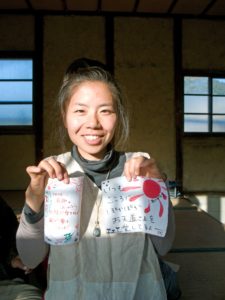
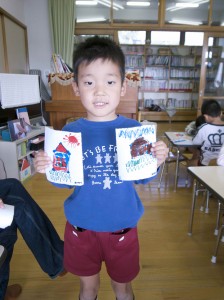
The materials for Sunset House reflect a deep connection between people and nature. For example I have been working exclusively with yakita, or burnt clapboards, for the exterior of the surface. These clapboards are used to resist the harsh ocean breezes in the Setouchi Inland Sea and have a unique aesthetic appeal. But I felt the structure would become too dark if it were entirely blackened, so I struggled to find other natural materials that would lighten the exterior to a more balanced composition. I found that raw wood could give a rough appeal to the section of the building where I chose to draw a circular form while maintaining a harmony of material with the burnt wood used for all of the other surfaces of the building. Additionally I added a mud wall section around the building near the roofline to draw a closer link between the interior mud walls and the exterior of the structure. Similar to the mixture used inside, I formulated a mix of local stone quarry dust to lighten the local mud used for composing earthen walls. Like many towns on the Island of Shodo, the history of this town is full of stories of a stone quarry that brought great abundance to the people in the area. I have also been purely fascinated with earth pigments for the past ten years and often incorporate these pigments into my artworks.
I will be presenting this work along with another site-specific installation titled Philosophy of Colors for an exhibition opening next week. There are still many components of the site I plan to work with in the future, therefore Sunset House will not be completed until 2013. Both artworks will be open to the public starting on December 10th and the exhibition details can be downloaded HERE. In addition to the new exterior of the building, each paper wish will be included in a video projection on the interior walls of the building. The project has been covered by a number of Japanese reporters so please read more about Sunset House in these articles which can be downloaded here 園児ら作家を”お手伝い” and 子供との描く夕焼けハウス as well as a radio broadcaster who wrote about my work on her blog after a recent visit to the studio which can be linked HERE. For those of you who cannot make it to see the work this month please stay tuned because this is a permanent installation work that will be on display again in the future.
